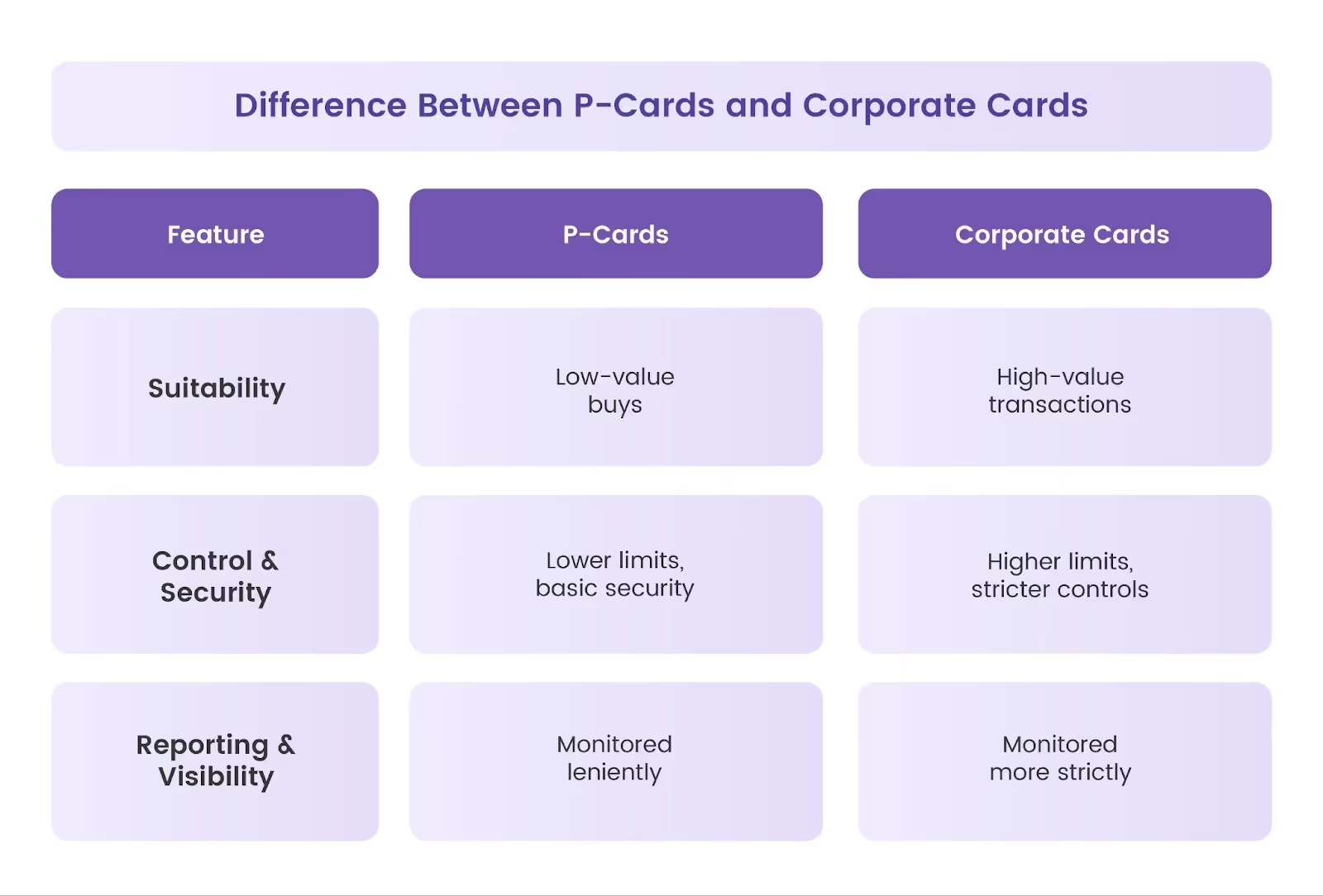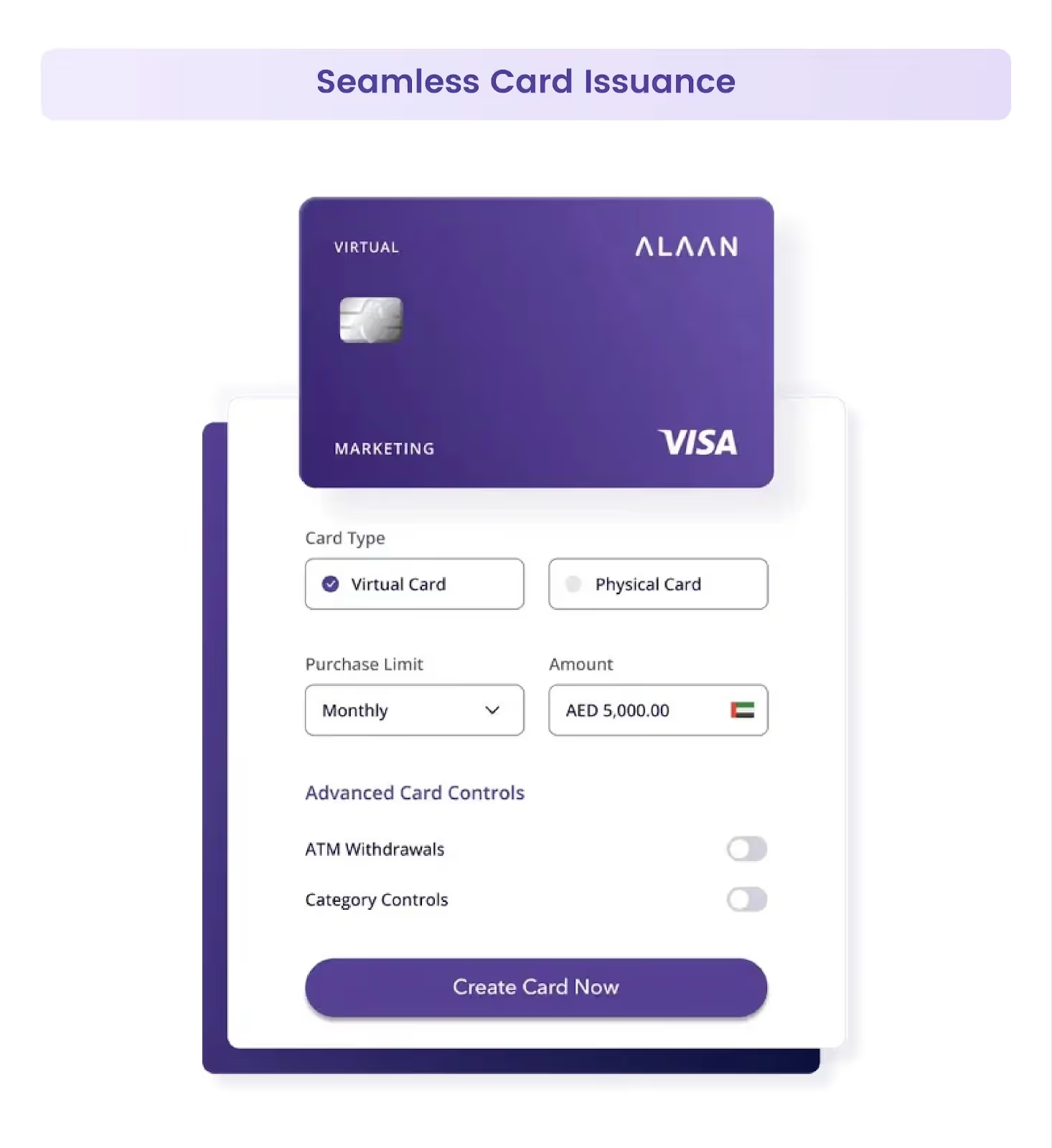Remember the time we missed a receipt or found it in a not-so-good condition? We've all been there—frantically searching receipts stuffed in our wallet, hoping that crumpled piece of paper proves we indeed bought that stapler (because, let's be honest, who remembers stapler prices?).
Well, this is tough—both for employees and finance department. And here is the step where cards or plastic money help. Corporate purchasing cards or P-cards are a spending channel companies use to simplify finances. But what exactly are they, and why should your business consider them? Let’s find out!
What is a corporate purchasing card?
A P-Card, also known as Purchasing Card or Procurement Card, is a company payment card issued to specific employees for authorised business purchases. Unlike personal credit cards, P-Cards come with spending limits and controls set by the company to ensure transactions align with company policies and objectives.
Think of them as credit cards for your business. The company loads money onto the card, and employees can use it for authorised purchases. Imagine needing printer ink for a crucial presentation. With a P-card card, you can buy it on the spot—no need to wait for reimbursements (which can be long and tedious).
Let's say you own a marketing agency in Dubai with 10 employees, including account managers, graphic designers, and a social media specialist. You implement a corporate purchasing card program to streamline procurement and control expenses.
You obtain cards from your P-card provider and issue them to specific employees with customised spending limits based on their roles. Account managers get higher limits for client entertainment and vendor payments, while designers have lower limits focused on office supplies and design software.
With detailed transaction reports provided by the corporate purchasing cards, your accounting team can easily track expenses, reconcile accounts, and identify areas for cost savings.
This way, you can gain better control and visibility over your agency's expenses, ultimately enhancing financial management and decision-making.
How do corporate purchasing cards work?

Issuance and authorisation
The first step in using purchasing cards is to obtain them from a purchasing card provider. These cards are typically issued to authorised employees entrusted to make purchases on behalf of your organisation.
During this step, ensure that:
- Each cardholder receives a customised card with specific spending limits and restrictions based on their role within the organisation.
- The cards have clear guidelines and policies regarding their usage, ensuring compliance and accountability.
- Employees authorised to use the cards undergo proper training sessions on the card's features and the company's procurement policies — this could be done in partnership with the procurement card provider.
Spending controls and limits
One key advantage of purchasing cards is the ability to set company spending controls and limits. As a business owner, you can establish individual spending limits for each cardholder and overall limits for the organisation. This allows you to manage and monitor expenses effectively, ensuring that spending stays within budget and aligns with your company's financial goals.
For example, a junior marketing associate might have a P-Card limit of 200 AED per month for office supplies, while a senior manager might have a limit of 500 AED. These limits can be adjusted based on historical spending patterns and departmental needs.
When setting these controls, consider the following:
- Align spending limits with each employee's role and responsibilities to ensure efficient and appropriate use of the cards.
- Establish overall limits for the organisation based on historical spending patterns and budgetary constraints.
- Regularly review and adjust spending limits to adapt to changing business requirements and spending trends.
While we’re at spending controls and limits, did you know Alaan corporate cards let you set customised spending limits based on your expense policies? Our Corporate card program comes with an integrated expense management platform that lets you set separate expense budgets with granular control for projects, departments, and categories. For example, you can allocate a specific budget for social media advertising within the marketing department's overall spending limit.

Merchant category restrictions
Another powerful feature of purchasing cards is the ability to restrict purchases from specific merchant categories. By customising these restrictions, you can control where and how the cards are used, ensuring that employees only make authorised transactions. Whether it's limiting specific purchases to office supplies, business travel expenses, or approved vendors, merchant category restrictions provide an added layer of security and compliance for your business.
For example, a construction company in Abu Dhabi needs to purchase building materials from a specific vendor. A Corporate Card with pre-approved merchant restrictions ensures the purchase is made from the authorised supplier while offering higher spending limits for such transactions.
When restricting merchant categories, keep in mind that the employees should be aware of the restricted categories and understand the rationale behind the restrictions.
Transaction approval processes
Some purchasing card programs have an in-built transaction approval process for larger purchases. This means that transactions exceeding a certain amount may require pre-approval before processing. By implementing this control mechanism, you can effectively manage high-value expenditures, prevent unauthorised spending, and maintain oversight over your company's financial transactions.
Let’s say your company implements a transaction approval process. Any P-Card purchase exceeding a specific amount (e.g.,1,000 AED) requires pre-approval from a designated manager before processing. This additional layer of control minimises the risk of unauthorised high-value purchases.
When implementing approval processes, ensure that:
- The approval thresholds are set at appropriate levels based on your company's policies and spending patterns.
- The approval process is streamlined and efficient, with clear guidelines on who has the authority to approve transactions.
- The approval process is consistently followed, and any exceptions are properly documented and justified.
Alaan’s corporate card solution lets you set your own approval policies to ensure control over business spending.

Reporting and reconciliation
Purchasing cards offer robust reporting capabilities that provide detailed insights into your company's spending patterns. Transaction reports generated by these cards make it easier to track expenses, reconcile accounts, and identify opportunities for cost savings. For example, Alaan gives you actionable insights in real-time on how you can optimise your spending.

Now that we’ve covered the basics of purchasing cards, let's examine the pros and cons of P-Cards to help you decide if they're the right fit for your business.
Pros and cons of purchasing cards
As mentioned, P-Cards offer a convenient solution for small business purchases. However, like any financial tool, they have advantages and disadvantages that require careful consideration before implementation. Here’s a quick look at the pros and cons:

Pros of Purchasing Cards:
- Efficient Procurement: P-Cards bypass the traditional purchase order process for low-cost items, saving significant time and resources. Employees can make approved purchases directly without requiring lengthy approval procedures, streamlining the procurement process.
- Better Cash Flow Management: Since payments are made based on a monthly statement, businesses can keep their cash longer, improving liquidity and financial flexibility. This allows for better working capital management and the ability to take advantage of early payment discounts from suppliers.
- Enhanced Transaction Transparency: Electronic records of P-Card transactions provide superior tracking and control over expenditures, enhancing financial oversight compared to cash transactions. This data can be used for detailed analysis of spending patterns and trends, helping to identify areas for cost savings and optimisation.
- Ease of Use for Employees: Employees can make approved purchases directly without needing to front personal money, simplifying their procurement process. This reduces the burden of expense reimbursement and improves employee satisfaction with purchasing.
Cons of Purchasing Cards:
- Risk of Fraud: P-Cards can be susceptible to misuse if lost or stolen, and weak controls can lead to unauthorised purchases by employees. This can result in significant financial losses if not detected and addressed promptly. Implementing robust controls, such as spending limits and transaction monitoring, is crucial to mitigate this risk.
- Accounting Challenges: Errors such as incorrect or incomplete expense reports can create difficulties in accounting and reconciliation, leading to potential financial discrepancies. Resolving these can be time-consuming and costly, especially if the errors are not detected in a timely manner. Clear policies and employee training on proper expense reporting procedures are essential to minimise these challenges.
- Potential for Overspending: The convenience of P-Cards may lead to impulse buying or unnecessary expenses if stringent spending limits and guidelines are not in place. Without proper oversight and controls, employees may make purchases not aligned with business objectives or budgets, leading to wasted resources and potential financial issues.
- Vendor Limitations: Not all suppliers accept P-Cards, which can limit their applicability and force businesses to find alternative payment methods for certain transactions. This can add complexity to the procurement process and potentially increase costs if alternative payment methods are more expensive.
- Administrative Complexity: Implementing and managing a P-Card program involves establishing policies, distributing and tracking cards, and monitoring expenditures, which can add significant administrative responsibilities. This requires dedicated resources and expertise to ensure the program is effectively managed and controlled, which can be challenging for smaller organisations with limited staff.
While P-Cards offer many benefits, corporate cards may present a more robust alternative. In the next section, we will explore the key differences between P-Card and corporate cards and why corporate cards might be the better option for your business.
P Cards vs. Corporate Cards
While both purchasing cards and corporate cards offer a convenient way to streamline the procurement process, corporate cards emerge as the superior choice due to their enhanced features and benefits.
Suitability
- P-Cards: These cards are great for low-value, routine purchases like office supplies or printer cartridges. Their lower spending limits make them ideal for controlled, everyday transactions.
- Corporate Cards: Corporate cards excel at handling large purchases like travel, entertainment expenses, and vendor payments. Their increased spending flexibility empowers authorised personnel to make crucial business decisions without unnecessary delays.
Control and Security
- P-Cards: While offering convenience, P-Cards come with inherent risk. Lower spending limits can be easily breached in cases of lost or stolen cards, and weak controls can leave businesses vulnerable to unauthorised purchases. Additionally, relying on detailed expense reports with receipts can be time-consuming and prone to errors.
- Corporate Cards: These cards provide a more robust security framework. Higher spending limits are typically coupled with stricter controls and verification processes, minimising the risk of fraud. Additionally, some Corporate Cards offer advanced features like real-time transaction tracking and spending alerts, empowering businesses to maintain tighter oversight.
Reporting and Visibility
- P-Cards: Corporate purchasing cards are monitored more leniently. This process can be error-prone and time-consuming, delaying reconciliation and hindering financial reporting and visibility.
- Corporate Cards: Corporate cards, on the other hand, are monitored more strictly to ensure compliance and accuracy. They offer streamlined reporting and real-time tracking, which enhances financial oversight and decision-making.

Our Verdict
While P-Cards offer undeniable convenience for employees making everyday purchases, Corporate Cards provide a more comprehensive solution. They streamline processes, improve cash flow, elevate security, reduce errors, and offer rewards programs that generate additional benefits for businesses. Here’s where Alaan comes into play.

Alaan: A streamlined corporate card solution
Alaan is a one-stop shop for all your corporate card needs. Alaan provides a seamless process for issuing both virtual and physical corporate cards to authorised employees.

This feature ensures quick access to payment methods for business transactions, whether online or in-person, enhancing convenience and flexibility in managing expenses.
It doesn’t stop there. With Alaan, you also gain access to a comprehensive expense management platform that simplifies the tracking and monitoring of corporate card transactions. It offers robust tools to manage expenses, generate reports, and analyse spending patterns, enabling businesses to optimise their financial management processes effectively.

Additionally, it offers real-time spending visibility, allowing businesses to monitor transactions as they occur and gain immediate insights into their expenditures. The platform leverages AI-powered analytics to provide valuable insights and recommendations based on spending patterns, empowering businesses to make informed decisions and optimise their financial strategies.
Ready to see how corporate cards can empower your finance team, streamline operations, and boost efficiency? Contact us today!


.avif)







